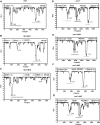Analysis of stress-induced duplex destabilization (SIDD) properties of replication origins, genes and intergenes in the fission yeast, Schizosaccharomyces pombe
- PMID: 23163955
- PMCID: PMC3533806
- DOI: 10.1186/1756-0500-5-643
Analysis of stress-induced duplex destabilization (SIDD) properties of replication origins, genes and intergenes in the fission yeast, Schizosaccharomyces pombe
Abstract
Background: Replication and transcription, the two key functions of DNA, require unwinding of the DNA double helix. It has been shown that replication origins in the budding yeast, Saccharomyces cerevisiae contain an easily unwound stretch of DNA. We have used a recently developed method for determining the locations and degrees of stress-induced duplex destabilization (SIDD) for all the reported replication origins in the genome of the fission yeast, Schizosaccharomyces pombe.
Results: We have found that the origins are more susceptible to SIDD as compared to the non-origin intergenic regions (NOIRs) and genes. SIDD analysis of many known origins in other eukaryotes suggests that SIDD is a common property of replication origins. Interestingly, the previously shown deletion-dependent changes in the activities of the origins of the ura4 origin region on chromosome 3 are paralleled by changes in SIDD properties, suggesting SIDD's role in origin activity. SIDD profiling following in silico deletions of some origins suggests that many of the closely spaced S. pombe origins could be clusters of two or three weak origins, similar to the ura4 origin region.
Conclusion: SIDD appears to be a highly conserved, functionally important property of replication origins in S. pombe and other organisms. The distinctly low SIDD scores of origins and the long range effects of genetic alterations on SIDD properties provide a unique predictive potential to the SIDD analysis. This could be used in exploring different aspects of structural and functional organization of origins including interactions between closely spaced origins.
Figures





Similar articles
-
DNA replication origins in the Schizosaccharomyces pombe genome.Proc Natl Acad Sci U S A. 2005 Jan 11;102(2):337-42. doi: 10.1073/pnas.0408811102. Epub 2004 Dec 28. Proc Natl Acad Sci U S A. 2005. PMID: 15623550 Free PMC article.
-
Physical mapping of origins of replication in the fission yeast Schizosaccharomyces pombe.Mol Biol Cell. 1994 Aug;5(8):839-49. doi: 10.1091/mbc.5.8.839. Mol Biol Cell. 1994. PMID: 7803852 Free PMC article.
-
Multiple orientation-dependent, synergistically interacting, similar domains in the ribosomal DNA replication origin of the fission yeast, Schizosaccharomyces pombe.Mol Cell Biol. 1998 Dec;18(12):7294-303. doi: 10.1128/MCB.18.12.7294. Mol Cell Biol. 1998. PMID: 9819416 Free PMC article.
-
Specification of DNA replication origins and genomic base composition in fission yeasts.J Mol Biol. 2013 Nov 29;425(23):4706-13. doi: 10.1016/j.jmb.2013.09.023. Epub 2013 Oct 3. J Mol Biol. 2013. PMID: 24095860 Review.
-
An Ancient Yeast for Young Geneticists: A Primer on the Schizosaccharomyces pombe Model System.Genetics. 2015 Oct;201(2):403-23. doi: 10.1534/genetics.115.181503. Genetics. 2015. PMID: 26447128 Free PMC article. Review.
Cited by
-
Chromosomal context and replication properties of ARS plasmids in Schizosaccharomyces pombe.J Biosci. 2015 Dec;40(5):845-53. doi: 10.1007/s12038-015-9572-y. J Biosci. 2015. PMID: 26648030
-
PomBase 2018: user-driven reimplementation of the fission yeast database provides rapid and intuitive access to diverse, interconnected information.Nucleic Acids Res. 2019 Jan 8;47(D1):D821-D827. doi: 10.1093/nar/gky961. Nucleic Acids Res. 2019. PMID: 30321395 Free PMC article.
References
Publication types
MeSH terms
LinkOut - more resources
Full Text Sources

